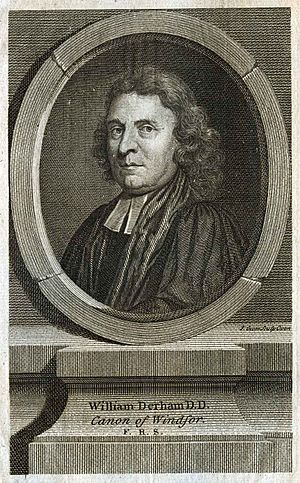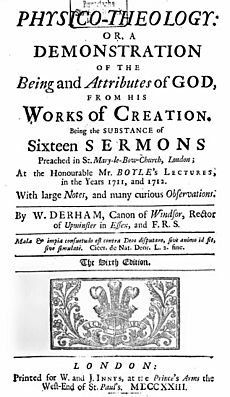William Derham facts for kids
Quick facts for kids
William Derham
|
|
|---|---|

18th-century tableau of William Derham
|
|
| Born | 26 November 1657 Stoulton, Worcestershire, England
|
| Died | 5 April 1735 (aged 77) Upminster, England
|
| Nationality | English |
| Alma mater | Trinity College, Oxford |
| Known for | Natural theology; Measurement of the speed of sound |
| Awards | Fellow of the Royal Society |
| Scientific career | |
| Fields | Physico-Theology |
| Influences | John Ray |
William Derham (born November 26, 1657, died April 5, 1735) was an English clergyman and a brilliant scientist. He was known for his studies of nature and for being the first to accurately measure the speed of sound. He was also a Fellow of the Royal Society, which is a group of top scientists.
Contents
William Derham's Early Life and Education
William Derham was born in a place called Stoulton in Worcestershire, England. His father was Thomas Derham. William went to school in Blockley, Gloucestershire.
Later, he studied at Trinity College, Oxford, from 1675 to 1679. After his studies, he became a priest on May 29, 1681.
Becoming a Vicar and Rector
In 1682, William Derham became the vicar of Wargrave, a town in Berkshire. Then, from 1689 until he passed away in 1735, he served as the Rector at Upminster, a village in Essex.
While he was at Upminster, he also became a Canon of Windsor in 1716. This meant he split his time between these two important roles. He was buried in Upminster, but his exact grave location is not known.
William Derham's Scientific Discoveries
William Derham was a very busy writer and scientist. He published many books and papers. His work often mixed science with ideas about God and nature.
In 1696, he wrote a book called Artificial Clockmaker. This book was very popular and was printed many times.
Books About Nature and God
Some of his most famous books were Physico-Theology, published in 1713, and Astro-Theology, published in 1714. He also wrote Christo-Theology in 1730.
These books explored how the natural world and the stars show evidence of a creator. But they also contained many of his own scientific observations. For example, in Physico-Theology, he wrote about how different animals of the same type can vary. He also knew that the Virginia opossum was the only marsupial (a type of mammal that carries its young in a pouch) in North America.
In his books, he even described an early idea for a marine chronometer. This was a very accurate clock that could be used on ships to help sailors find their location. He was the first person to use the word chronometer.
Discoveries in Space
His book Astro-Theology talked about several new nebulae. Back then, a nebula was the name for any fuzzy, spread-out object in the sky. Some of what he called nebulae are now known as star clusters.
He used a very long telescope, about 16 feet long, for his observations. This telescope was placed at the top of the tower of St Laurence's Church in Upminster. The church still has the special doors that were used for his telescope.
Joining the Royal Society
On February 3, 1703, William Derham was chosen to be a Fellow of the Royal Society. This is a great honor for scientists. He also gave a series of important lectures called the Boyle Lectures in 1711–1712.
Besides his own books, Derham wrote many articles for the Transactions of the Royal Society. He also helped edit and publish the writings of other famous scientists, like John Ray and Robert Hooke. His notes on the weather in Upminster are some of the earliest weather records in England.
How William Derham Measured the Speed of Sound
One of William Derham's most important achievements was measuring the speed of sound. In 1709, he published a very accurate measurement: 1,072 Parisian feet per second.
To do this, Derham used his telescope from the tower of the church of St Laurence, Upminster. He would watch for the flash of a distant shotgun being fired. Then, he would use a special pendulum (a weight swinging back and forth) to measure the time until he heard the gunshot.
He took measurements from different places, like the Church of St Mary Magdalene, North Ockendon. He knew the exact distance to these places by using a method called triangulation. By knowing the distance and the time it took for the sound to travel, he could calculate how fast the sound was moving.
Works
- The Artificial Clockmaker (1696)
- --- (1734 edition)
- Physico-theology, or a Demonstration of the Being and Attributes of God (1723 edition)
- Christo-Theology: Or, a Demonstration of the Divine Authority of the Christian Religion (1730 edition)
- A defence of the churches right in leasehold estate, London: W. Innys 1731.
- Astro-theology: or, A demonstration of the being and attributes of God, from a Survey of the Heavens (1731 edition)
See also
- Astrotheology


